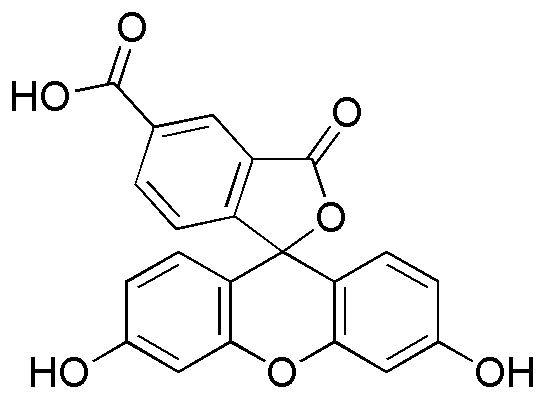5-Carboxyfluorescein is widely utilized in research focused on:
- Fluorescent Probes: This compound serves as an effective fluorescent marker in biological assays, allowing researchers to visualize cellular processes and track biomolecules in real-time.
- pH Indicators: Due to its pH-sensitive fluorescence, it is used in various applications to measure acidity levels in solutions, making it valuable in environmental monitoring and food safety testing.
- Drug Delivery Systems: Its properties enable it to be incorporated into drug formulations, enhancing the tracking of drug release and distribution within biological systems, which is crucial in pharmaceutical research.
- Immunoassays: The compound is commonly employed in enzyme-linked immunosorbent assays (ELISAs) for the detection of specific proteins, aiding in clinical diagnostics and research.
- Bioconjugation: It is often used to label antibodies and other biomolecules, facilitating studies in proteomics and molecular biology by improving the detection and analysis of target molecules.
Informations générales
Propriétés
Sécurité et réglementation
Applications
5-Carboxyfluorescein is widely utilized in research focused on:
- Fluorescent Probes: This compound serves as an effective fluorescent marker in biological assays, allowing researchers to visualize cellular processes and track biomolecules in real-time.
- pH Indicators: Due to its pH-sensitive fluorescence, it is used in various applications to measure acidity levels in solutions, making it valuable in environmental monitoring and food safety testing.
- Drug Delivery Systems: Its properties enable it to be incorporated into drug formulations, enhancing the tracking of drug release and distribution within biological systems, which is crucial in pharmaceutical research.
- Immunoassays: The compound is commonly employed in enzyme-linked immunosorbent assays (ELISAs) for the detection of specific proteins, aiding in clinical diagnostics and research.
- Bioconjugation: It is often used to label antibodies and other biomolecules, facilitating studies in proteomics and molecular biology by improving the detection and analysis of target molecules.
Documents
Fiches de données de sécurité (FDS)
La FDS fournit des informations de sécurité complètes sur la manipulation, le stockage et l’élimination du produit.
Spécifications du produit (PS)
Le PS fournit une description complète des propriétés du produit, notamment sa composition chimique, son état physique, sa pureté et les exigences de stockage. Il détaille également les plages de qualité acceptables et les applications prévues du produit.
Certificats d'analyse (COA)
Recherchez des certificats d'analyse (COA) en saisissant le numéro de lot du produit. Les numéros de lot et de lot se trouvent sur l'étiquette d'un produit, après les mots « Lot » ou « Lot de fabrication ».
Numéro de catalogue
Numéro de lot/série
Certificats d'origine (COO)
Ce certificat d'exploitation confirme le pays dans lequel le produit a été fabriqué, et détaille également les matériaux et composants utilisés et s'il est issu de sources naturelles, synthétiques ou autres sources spécifiques. Ce certificat peut être requis pour les douanes, le commerce et la conformité réglementaire.
Numéro de catalogue
Numéro de lot/série
Fiches de données de sécurité (FDS)
La FDS fournit des informations de sécurité complètes sur la manipulation, le stockage et l’élimination du produit.
DownloadSpécifications du produit (PS)
Le PS fournit une description complète des propriétés du produit, notamment sa composition chimique, son état physique, sa pureté et les exigences de stockage. Il détaille également les plages de qualité acceptables et les applications prévues du produit.
DownloadCertificats d'analyse (COA)
Recherchez des certificats d'analyse (COA) en saisissant le numéro de lot du produit. Les numéros de lot et de lot se trouvent sur l'étiquette d'un produit, après les mots « Lot » ou « Lot de fabrication ».
Numéro de catalogue
Numéro de lot/série
Certificats d'origine (COO)
Ce certificat d'exploitation confirme le pays dans lequel le produit a été fabriqué, et détaille également les matériaux et composants utilisés et s'il est issu de sources naturelles, synthétiques ou autres sources spécifiques. Ce certificat peut être requis pour les douanes, le commerce et la conformité réglementaire.


